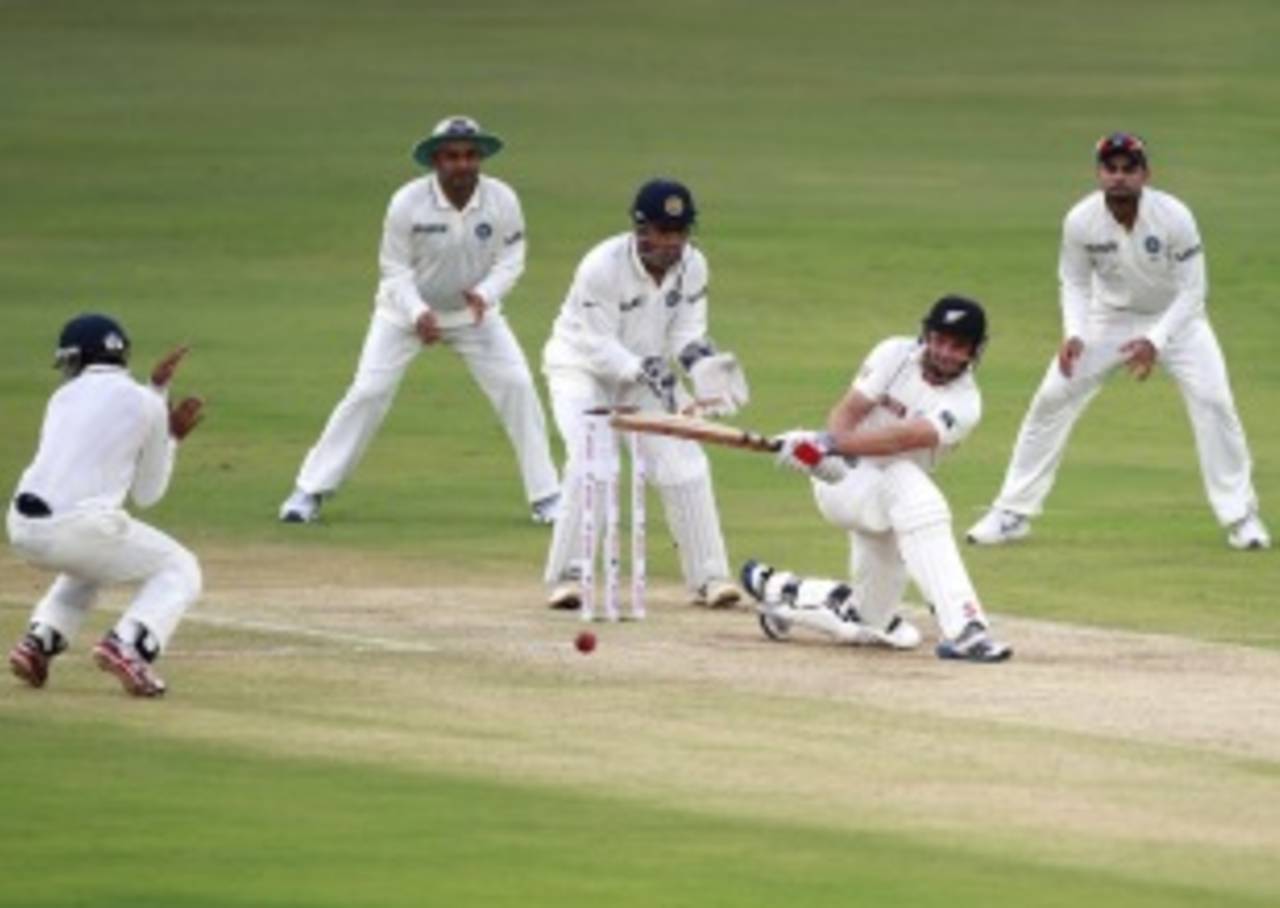India's fielding set to play bigger role
India may have lost years of slip-fielding experience with Dravid and Laxman's departure, but younger players promise new energy
Abhishek Purohit in Hyderabad
26-Aug-2012

India's new-look slip cordon appeared to be in good hands • Associated Press
No Dravid, no Laxman. Apart from all those runs, 'who will catch 'em in the slips now' was the question before this series started. On the evidence of the Hyderabad Test, Virender Sehwag has over the years, and will continue to catch 'em, with the addition of Virat Kohli. And yes, as an inevitable by-product of having two young men replace two not-so-young men, India's fielding will have more energy, and will play a bigger role in the game.
India caught almost everything that came their way, barring a tough chance put down at second slip by Kohli off Martin Guptill's edge in New Zealand's second innings. It was a somewhat difficult pitch for close-in men. There was variable bounce; some edges would carry, some would not. It was also a slow wicket; many catches went low. But India's new group of close-in fielders passed this test.
"I thought there were a couple of very good catches that were pulled out," R Ashwin, five of whose 12 wickets came off close-in catches, said. "As a spinner, you know when catches are being taken, it puts the batsmen under a lot of pressure and it's definitely something you relish as a spinner. I thought it was a terrific catch by Sehwag to dismiss [James] Franklin. That's the kind of support you expect. From three wickets, I could push on to five wickets and close out the game today. So it makes a difference."
Sehwag was outstanding at first slip, where he stood in place of Dravid, the man with the most field catches in Test history. Sehwag and Dravid were at opposite ends in their approach to batting; the difference carries over into standing in the slips as well. Dravid was all focus; till the very last moment, Sehwag would appear as if he is standing at fine leg. He would roll his wrists, crack a joke, smile broadly, he would even acknowledge the crowd chanting his name with a back-waving gesture. Just as the ball is about to be delivered though, he will put his hands on his knees and concentrate. And pull off stunners like the one against Franklin, when he dived one-handed to his right to snap up a thin edge which had nearly brushed the keeper's gloves.
Kohli exudes intent even when he walks down for the presentation; so it was to be expected that he would stand in the slips and at backward short leg as if that was what he had wanted to do. All three of his close catches were sharp, low chances. The first two were at backward short leg, a difficult position because of the angle and visibility. Kohli's reactions were as sharp and quick as the chances. He stands with feet wide apart, arches forward markedly with his back almost horizontal to the ground and remains very still. India have a new asset around the bat. Suresh Raina was the third man in the slip cordon, but he wasn't tested. We already know his value in the inner ring; hopefully for India, he can carry that value into the slips.
Another young man, Cheteshwar Pujara, stood at forward short leg. And dived around to stop the ball from passing him. Pujara got hit by a Kane Williamson pull and had to leave the field. In came another young man, Ajinkya Rahane, and dived around at the same position. He was to get hit as well later, but carried on after treatment.
India saved numerous singles and cut down potential threes into twos and twos into ones with energetic chasing and sliding throughout their time on the field. That adds considerably to the pressure on the batting side. With Sehwag set to spend almost all his time on the field in the slips now, and Sachin Tendulkar as effective and enthusiastic as a 39-year old can be, India have only Zaheer Khan and Ashwin as the slow men in this XI. Even more encouraging is the strong possibility that all these young fielders could prove to be as effective wherever they are used; whether on the boundary, in the ring, or close to the bat. The future is here, and it is looking good.
Abhishek Purohit is an editorial assistant at ESPNcricinfo